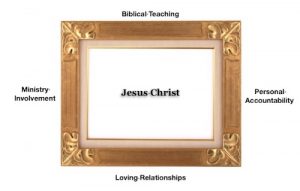What brings you joy? A rise in the stock market? A lower golf score? An A on your exam? Fine dining at restaurant? While they may bring some temporary happiness, spiritual ministry provides abiding joy. The Apostle John declared: “I have no greater joy than to hear that my children walk in truth” (3 John 4). The apostle’s “children” were his spiritual children–those he had discipled publicly and personally.
Is the ministry of discipleship only for apostles, pastors, and missionaries? By no means! We have Christ’s Great Commission as the primary task of the New Testament people of God:
“And Jesus came and spoke to them, saying, ‘All authority has been given to Me in heaven and on earth. Go therefore and make disciples of all the nations, baptizing them in the name of the Father and of the Son and of the Holy Spirit, teaching them to observe all things that I have commanded you; and lo, I am with you always, even to the end of the age. Amen'” (Matt. 28:18-20).
If you know the Lord Jesus, can I ask you a personal question? Are you involved in a ministry of discipling? Pastor Ray Stedman summoned “lay” Christians to get in on the joy of discipleship: “The priesthood of every believer which Scripture teaches so clearly … has been opposed by much of the institutional church through the centuries. Martin Luther recovered it briefly during the Reformation, but it was soon lost to sight again. Yet nothing is more encouraging to a servant of Christ than to see the Lord honoring his ministry by radical and permanent changes made in the lives of those lives he touches.”[1]
But, you may be thinking, OK, all of us are to be involved in making disciples, but what does that look like? Is it teaching a Sunday School class? Witnessing? Doing community service? Preaching? It could be all–or none–of the above, depending on the content and manner of one’s service. A ministry that is so central to our calling as believers needs to be clearly understood and practically described.

Imagine a portrait–a beautiful oil painting of Christ-likeness that is displayed in an elegant wooden frame. The countenance of the portrait is attributed to the Spirit of Christ who indwells every true believer (Rom. 8:11). Here is the dynamic source of spiritual growth: ” … Christ in you, the hope of glory” (Col. 1:27; see Phil. 2:13; John 14:17,18).
The indwelling Christ empowers and directs the spiritual life; He is “the countenance of the portrait.” The wooden frame that enhances this portrait will represent the conditions of how disciples are made. Since a frame has four sides, each one will represent a basic element in making disciples. Let’s consider a portrait of discipleship. To cultivate the centrality of Christ’s grace and truth, we need to minister in four ways — “the sides of the portrait’s frame.”
A disciple is literally a “learner.” The Great Commission is explicit in stating “go ye therefore and teach all nations” (KJV). What needs to be taught–and learned? Much could be mentioned here, but essentially the discipler teaches the Word of God (2 Tim. 4:1-4), the doctrines of Scripture (Titus 2:1), godly character (Titus 2:2-9), and equipping for ministry (Eph. 4;12).
The first and foremost lesson is to know and believe the gospel. Spiritual life can not be cultivated if it is not present. Therefore, discipleship begins with personally receiving Christ through repentance and faith: “But as many as received Him, to them He gave the right to become children of God, to those who believe in His name” (John 1:12; 5:24; Eph. 2:8,9). Also, no regenerate believer can live victoriously unless he/she abides in Christ (John 15:5). Spiritual disciplines apart from personal fellowship with Christ are just religious activity. Yet, Christ living in and through the believer brings life transformation (2 Cor. 3:17,18; Gal. 2:20).
The scope of learning for the disciple should be biblically and practically comprehensive. As Paul testified to the elders of Ephesus, “For I have not shunned to declare to you the whole counsel of God” (Acts 20:27). Of course, to be equipped to teach others, we need to be perpetual learners ourselves![2]
Christ invites us all to be learners of Him: “Come to Me, all you who labor and are heavy laden, and I will give you rest. Take My yoke upon you and learn from Me …” (Matt. 11:28,29).
Although every believer needs to feed him/herself from the Word, this is supplemented and guided by teaching gifts in the church (Rom. 12:7; Eph. 4:11,12), and the mentoring of more mature believers (Heb. 5:11-14; Titus 2:1-4). But discipleship is much more than teaching! This leads us to the next side of the portrait’s “frame.”
The Lord Jesus uniquely modeled the discipleship process. When He prepared to wash the disciples feet at the Last Supper, we are told, “… having loved His own who were in the world, He loved them to the end” (John 13:1; Cf. 15:12,13). The disciples did not merely meet the Lord Jesus for a weekly lesson; they shared His life! Notice this description of Christ’s strategy for discipleship: “Then He appointed twelve, that they might be with Him …” (Mark 3:14). They were “with Him” almost “24/7” for over three years! This provided natural opportunities to ask questions, observe the Lord, and embrace His values (see Luke 11:1).[3]
The Old Testament gives a picture of teaching and loving relationships as they apply to parents discipling their children. Moses instructed,
“You shall love the LORD your God with all your heart, with all your soul, and with all your strength. And these words which I command you today shall be in your heart. You shall teach them diligently to your children, and shall talk of them when you sit in your house, when you walk by the way, when you lie down, and when you rise up…” (Deut. 6:5-7).
The late Christian musician and songwriter, Rich Mullins, appreciated the teaching and compassion he witnessed in his mother. His biographer noted, “Rich recalled how his mother was friendly toward an eccentric woman. ‘You know, I have a great mom. It is just wild that this woman and my mom are friends. I asked, “Do you ever feel weird around her?” and my mom said, “Yeah, sure I do! But here’s the deal: No one was ever won into the kingdom of God through snobbery. We come to know Christ through love. I really believe that.”‘ His mother’s love won Rich into the kingdom as well.” [4]
Disciple making cannot bear fruit without loving relationships. In his book, The Normal Christian Worker, Watchman Nee remarked, “Brothers and sisters, in the light of God’s passionate concern for people, can you still regard your fellows with indifference? We shall be worthless in His service unless our hearts are enlarged and our horizon is widened. We need to see the value God has placed on people.” [5]
The familiar saying still applies, “people will not care how much you know unless they know how much you care.” And where do we get this love? By the indwelling Holy Spirit! “The love of God has been poured out in our hearts by the Holy Spirit who was given to us” (Rom. 5:5).
.
Part 1 of 2
Notes:
[1] Ray Stedman, Authentic Christianity (Multnomah), p. 168.
[2] Gary Kuhne has organized a discipleship curriculum around three key ares: devotional, doctrinal, and discipleship (training). Devotional topics include salvation, assurance, devotions, prayer, memory, Bible study, confession, temptation, Holy Spirit, obedience, discipline, habits, guidance, stewardship, and church. Discipling in the area of doctrine covers Bible doctrine, systematized Bible knowledge, apologetics, and counseling issues. And under discipleship (training) are these topics: evangelism (sharing the gospel), personal testimony, follow up, counseling (skills), apologetics, and time management. (This list is not given as a requirement, but as an example of the scope and potential of discipling another believer.) The Dynamics of Personal Follow Up (Zondervan), pp.76-86
[3] Discipleship through loving relationships is the bridge for sharing values (Acts 4:13), allows for a positive example (John 13:12-15), provides encouragement (Rom. 14:19), and accountability (Luke 10:17-24).
[4] James Bryan Smith, Rich Mullins: An Arrow Pointing to Heaven (Broadman and Holman), p. 12,13.
[5] Watchman Nee, The Normal Christian Worker (CLC), p. 38.
Honorable Mention
A web site that shares the gospel to visitors is www.GoodNews4you.ca. Please visit and pass it on.

















